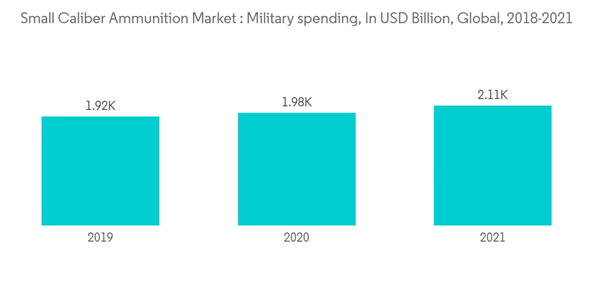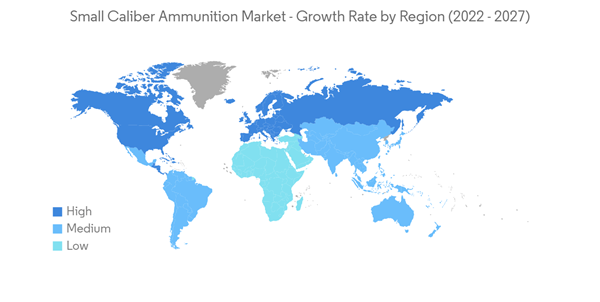The Small Caliber Ammunition Market size is estimated at USD 6.13 billion in 2024, and is expected to reach USD 7.77 billion by 2029, growing at a CAGR of 4.84% during the forecast period (2024-2029).
The COVID-19 pandemic has had a very minimal impact on the small caliber ammunition market as the procurement programs of armed forces for new-generation military arms and ammunition along with the defense budget have remained unaffected.
The growth of the small caliber ammunition market is subjective to several associative factors, such as the allocation of funds for procurement of new equipment, and may be adversely affected due to the rapid technological advances resulting in a short-effective life of newly developed technology.Increasing investments in defense for military modernization programs to procure better equipment to replace its existing arsenal is also acting as one of the key market drivers of the small-caliber ammunition market.
The stringent laws on gun ownership act as a key restrain for the growth of the small caliber ammunition market during the forecast period. The growing emphasis on gun control measures to reduce accidental gun deaths and injuries, domestic violence-related deaths, homicides, and suicides may even make the licensed rifle purchasing processes difficult during the upcoming period. This is expected to deter the growth of the market during the forecast period.
Also, several militaries have been involved in peacekeeping missions and counter-insurgency operations in foreign countries and require a continuous supply of ammunition for continuing their operations. This has been one of the primary growth factors for the segment. However, as the US-led troops moved out of the conflict zones, such as Afghanistan, Iraq, and Somalia in 2021, the market for small military caliber ammunition is expected to register lower growth in the years to come, compared to the growth observed in the last decade. Militaries are increasingly moving towards higher calibers like 7.62 mm projectiles, as the existing widely used calibers like the 5.56 mm are becoming ineffective in piercing the tougher armors. Countries like the United States and India are also developing firearms based on new calibers like the 6.8 mm ammunition, which are expected to witness higher demand in the years to come.
On the other hand, civilians in the US alone account for more than about 45% of the worldwide total of civilian-held firearms. Government initiatives aimed at creating personal safety awareness programs drive the country's civilian small arms and ammunition demand. Programs like the Civilian Marksmanship Program promote firearm safety training and rifle practice for citizens, focusing on youth. However, as the gun-related violence in the country increased over the past few years, the government has been making strict gun policies to regulate gun prefoliation.
This product will be delivered within 2 business days.
The COVID-19 pandemic has had a very minimal impact on the small caliber ammunition market as the procurement programs of armed forces for new-generation military arms and ammunition along with the defense budget have remained unaffected.
The growth of the small caliber ammunition market is subjective to several associative factors, such as the allocation of funds for procurement of new equipment, and may be adversely affected due to the rapid technological advances resulting in a short-effective life of newly developed technology.Increasing investments in defense for military modernization programs to procure better equipment to replace its existing arsenal is also acting as one of the key market drivers of the small-caliber ammunition market.
The stringent laws on gun ownership act as a key restrain for the growth of the small caliber ammunition market during the forecast period. The growing emphasis on gun control measures to reduce accidental gun deaths and injuries, domestic violence-related deaths, homicides, and suicides may even make the licensed rifle purchasing processes difficult during the upcoming period. This is expected to deter the growth of the market during the forecast period.
Small Caliber Ammunition Market Trends
The Military Segment Accounted for a Major Market Share
The growing threats due to terrorism, territorial conflicts, and geopolitical tensions have forced the countries to increase their defense spending. global defense expenditure continued to increase in 2020 and 2021. According to SIPRI, the global military expenditure in 2021 rose to USD 2113 billion, an increase of 7% from 2020. billion. Global spending in 2021 was 19% higher than in 2012. The growing defense budgets have facilitated the increasing investments in military modernization programs aimed at procuring better weapons to supplement or replace the existing weapons arsenal. The impact of military modernization on the ammunition market is being witnessed in countries like Germany, France, India, China, and Russia, which are spending significantly on enhancing the capabilities of their ground forces by inducting state-of-the-art small arms. The need to maintain a sufficient ammunition inventory with the militaries worldwide and the increasing demand for training ammunition is also anticipated to impact the small military caliber ammunition segment positively.Also, several militaries have been involved in peacekeeping missions and counter-insurgency operations in foreign countries and require a continuous supply of ammunition for continuing their operations. This has been one of the primary growth factors for the segment. However, as the US-led troops moved out of the conflict zones, such as Afghanistan, Iraq, and Somalia in 2021, the market for small military caliber ammunition is expected to register lower growth in the years to come, compared to the growth observed in the last decade. Militaries are increasingly moving towards higher calibers like 7.62 mm projectiles, as the existing widely used calibers like the 5.56 mm are becoming ineffective in piercing the tougher armors. Countries like the United States and India are also developing firearms based on new calibers like the 6.8 mm ammunition, which are expected to witness higher demand in the years to come.
North America is the Largest Market for Small Caliber Ammunition
The US has one of the largest armed forces in the world, with 1.83 million total military personnel. The US is also the largest military spending country in the world. In 2021, the United States spent around 800.67 billion U.S. dollars on its military. The United States had around 750 bases in at least 80 countries worldwide as of July 2021. In addition to active combat, US personnel are typically deployed as part of several peacekeeping missions, and military attachés, or are part of the embassy, consulate security, and several other classified missions. Such deployments have significantly contributed toward the growth of the procurement of arms and ammunition by the US armed forces. The United States launched the Next Generation Squad Weapon (NGSW) program, aiming to replace the 5.56x45mm caliber M4 Carbine, M249 SAW (Squad Automatic Weapon), and 7.62x51mm caliber M240 machine guns with rifles that utilize a common 6.8mm caliber cartridge. The contract for the NGSW rifle is anticipated to provide weapon suppliers (among True Velocity and Sig Sauer, Inc.) by the end of 2022.On the other hand, civilians in the US alone account for more than about 45% of the worldwide total of civilian-held firearms. Government initiatives aimed at creating personal safety awareness programs drive the country's civilian small arms and ammunition demand. Programs like the Civilian Marksmanship Program promote firearm safety training and rifle practice for citizens, focusing on youth. However, as the gun-related violence in the country increased over the past few years, the government has been making strict gun policies to regulate gun prefoliation.
Small Caliber Ammunition Industry Overview
The small caliber ammunition market is fragmented due to the presence of several local and global players in the market. Some prominent players in the small caliber ammunition market include CBC Global Ammunition, Northrop Grumman Corporation, General Dynamics Corporation, Nammo AS, and Olin Corporation. Most countries produce small ammunition through local production capacities and minimal orders given to foreign players to meet specific caliber shortages of ammunition of purpose with military applications. For instance, the Kenya Ordnance Factories Corporation (KOFC) is the local manufacturing company in Kenya that manufactures small-caliber ammunition and related products delivered to Kenyan armed forces, security agencies, and licensed arms dealers. It exported it to allied countries in Africa. The manufacturing facility's capacity is estimated to be at least 20,000 bullets per day. Similarly, INDUMIL, FAMAE, and Aguila Ammunition are the local manufacturers of small caliber ammunition in Colombia, Chile, and Mexico, respectively, that cater to local demand. NATO members and players in the NATO countries benefit from ammunition demand originating from other NATO members and thus have adequate market presence in the military market.Additional Benefits:
- The market estimate (ME) sheet in Excel format
- 3 months of analyst support
This product will be delivered within 2 business days.
Table of Contents
1 INTRODUCTION
4 MARKET DYNAMICS
5 MARKET SEGMENTATION
6 COMPETITIVE LANDSCAPE
Companies Mentioned (Partial List)
A selection of companies mentioned in this report includes, but is not limited to:
- Northrop Grumman Corporation
- General Dynamics Corporation
- BAE Systems PLC
- Denel SOC Ltd
- Remington Arms Company LLC
- CBC Global Ammunition
- RUAG Group
- MESKO
- Nammo AS
- Olin Corporation
- CCI Ammunition
- Elbit Systems Ltd
- Ordnance Factory Board (OFB)
- PT Pindad
Methodology

LOADING...










